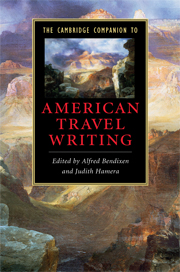Book contents
- Frontmatter
- Introduction: new worlds and old lands - the travel book and the construction of American identity
- Part I Confronting the American landscape
- 1 Beginnings: the origins of American travel writing in the pre-revolutionary period
- 2 “Property in the horizon”: landscape and American travel writing
- 3 New York to Niagara by way of the Hudson and the Erie
- 4 The Mississippi River as site and symbol
- 5 The Southwest and travel writing
- Part II Americans abroad
- Part III Social scenes and American sites
- Chronology
- Further Reading
- Index
4 - The Mississippi River as site and symbol
from Part I - Confronting the American landscape
Published online by Cambridge University Press: 28 March 2009
- Frontmatter
- Introduction: new worlds and old lands - the travel book and the construction of American identity
- Part I Confronting the American landscape
- 1 Beginnings: the origins of American travel writing in the pre-revolutionary period
- 2 “Property in the horizon”: landscape and American travel writing
- 3 New York to Niagara by way of the Hudson and the Erie
- 4 The Mississippi River as site and symbol
- 5 The Southwest and travel writing
- Part II Americans abroad
- Part III Social scenes and American sites
- Chronology
- Further Reading
- Index
Summary
So the story goes: not long before his death in 1986, Jorge Luis Borges made a pilgrimage to Hannibal, Missouri. Though eighty-three years old and nearly blind, the Argentinian author insisted on visiting one site as soon as he arrived in the town that had been the childhood home of Mark Twain. He was escorted to the river. Then - accounts differ - Borges completed his pilgrimage by dipping his hand or, more dramatically, by wading bodily into the current of the Mississippi. Either way, his moment of contact with the river led him to the same conclusion: “Now I understand the essence of America.” Apocryphal though Borges' moment of enlightenment may have been, it tells in miniature a story that has been rewritten for centuries. Since the moment Hernando De Soto and his party of conquistadors first arrived at the banks of the Mississippi in 1541, travelers of every variety have flocked to and along this representative river to better comprehend the country through which it flows. Both as a conduit for trade and travel, and a destination in its own right, the river's role in national life has changed dramatically over the centuries. It no longer commands the social and economic power of its antebellum zenith. Nevertheless, it continues to occupy a unique place in American travel writing - and the American consciousness. In the early nineteenth century, Reverend Timothy Flint felt that his first sighting of the river “left on my mind a most deep and durable impression, marking a period, from which commenced a new era in my existence.”
- Type
- Chapter
- Information
- The Cambridge Companion to American Travel Writing , pp. 62 - 77Publisher: Cambridge University PressPrint publication year: 2009
- 3
- Cited by



